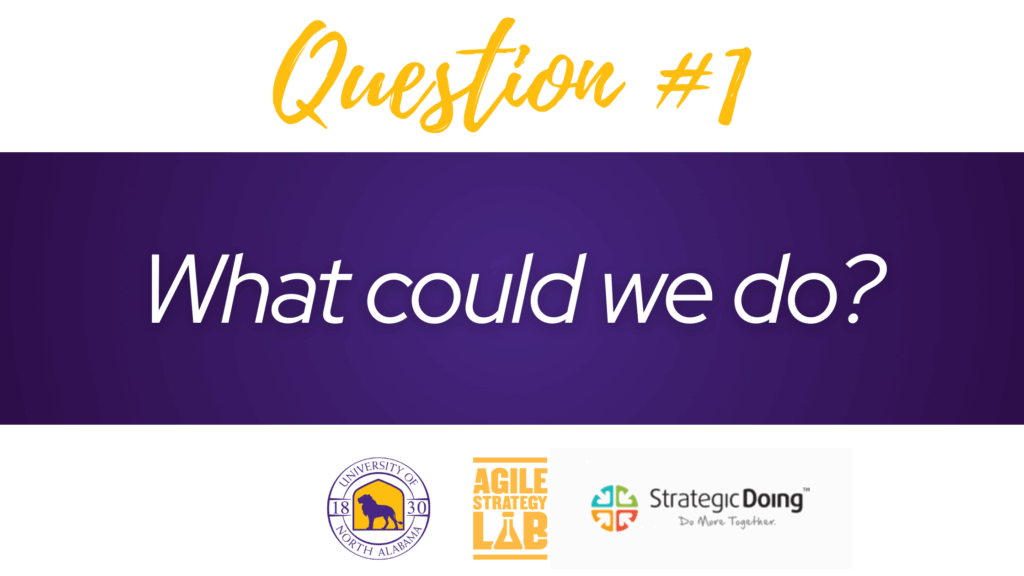What could we do?
This is the third post in our 14-week series exploring the 4 Questions and 10 Rules of Strategic Doing, first outlined in this October 2023 blog post. Each week, we take a closer look at one question or rule and unpack how to put it into practice. If you missed last week’s post on Rule #2: Frame the Conversation Around an Appreciative Question, catch up first—it sets the tone for asking better questions.

The first question of Strategic Doing is “what could we do?” But the question is also useful for contexts outside of that setting, and in this post we’ll explore how to use it.
When we are part of a group that has the intention of making something happen (and there are plenty of groups that…don’t), this isn’t usually the first question. Usually, the question posed is some variation of “so, what are we going to do?” But, that’s not the right first question (spoiler alert: it’s a great third question – stay tuned).
Why that question doesn’t work (right away)
There are several reasons that “what are we going to do?” isn’t the best question for a group to start with (and by group I mean any more than a single person).
First, this question can be threatening or at least alarming (especially if the group is new, and if there’s any sense of voluntary-ness in participating). This is particularly true if not everyone in the group has history together. The unspoken response is often, “You don’t even know me, and now you’re assuming I want to work with you?” (after all, very few people actually want to be part of the Married at First Sight reality show). If forced, you may get people offering very small ideas. The group is probably capable of more – but you’ll never know if you start this way.
But, that question is not alarming to one particular kind of group member, and that leads to the second problem. By leading with this question you’re inviting in rogue ideas with no way to deflect them. If you have a group member that has their own agenda, or a pet project they’ve been waiting to get a group to adopt, they’ll jump right in, happy that there’s little competition for their idea. The group can easily end up adopting it because it’s the only thing being discussed, or because the person who proposed it has some kind of power or status. It doesn’t mean it’s a good idea – but there’s no process in place for evaluating what’s offered.

Third, this question, when asked first, lacks critical context. As the Cheshire Cat said to Alice, “When you don’t know where you’re going, any road will do.” Or worse, when every member of the group has their own sense of the destination…no road will do. Neither is an effective use of the group’s time.
What question does work?
“What could we do (together)?” is a much better way to start a group’s conversation. It avoids the pitfalls described, while building relationships that will allow members of the group to build trust. It’s open enough to allow everyone to participate.
This question can work well both in one-on-one conversations and with larger groups. It’s at its best when you’ve already made use of the first two agile leadership skills: making sure you have a safe space for the conversation, and framing the conversation with a good question.
(what’s the difference between a framing question and this one? Think of the framing question as a big map page – it says “we’re going to go somewhere here – not somewhere on a different page.” Then, “what could we do?” is about what you’re going to do on that page)
How to use “what could we do?”
Whether one-on-one or in a larger group, “what could we do?” is an invitation to do some dreaming together, with minimal constraints.
One-on-one, don’t get too hung up on vetting the ideas – let them flow. The conversation is as much about building trust as it is about setting a direction. You’re testing out the proposition of working together – does this person seem to have similar values? Are their priorities aligned with yours? Or are they trying to take the conversation over from that very first moment?
In a larger group, the conversation is probably more formal/structured, and it needs to look a little different: you want lots of ideas at this stage. If you’re facilitating, you’re working to keep the group open to many possibilities, rather chasing one idea that seems promising. If your group has that person with a “pet project,” put it on the list, but it’s just one idea among many for now.
(One effective way to manage that interaction is to concentrate on – and express appreciation for – the “how” of the idea, not the “what” – the person’s skills, connections or other resources that they have that go into their idea)
If it’s a Strategic Doing workshop (or even if you’re just using the concepts), the “what could we do?” the discussion should take into account the assets of the group (more on that in the next posts). In general, you don’t want to strike an idea off the list early in the conversation, but if the group has none of the resources that would be needed, it’s probably best to put it into the “maybe we can revisit this one later when we’re better situated” column. Encourage ideas that use multiple assets from multiple people.
Action step: have a one-on-one discussion with someone that you’d like to work with at some point, in some context, and just try out a “what could we do (together)?” conversation. Surprisingly often, “hypothetical” ideas grow into ones that you’re motivated to put into action.
Learn more: A discussion around “what could we do?” is a divergent conversation, and it’s a key skill for creativity – here’s a video that breaks that idea down further.

Liz shepherds the expansion of the Lab’s programming and partnerships with other universities interested in deploying agile strategy tools. A co-author of Strategic Doing: 10 Skills for Agile Leadership, she also focuses on the development and growth of innovation and STEM education ecosystems, new tool development, and teaching Strategic Doing.
